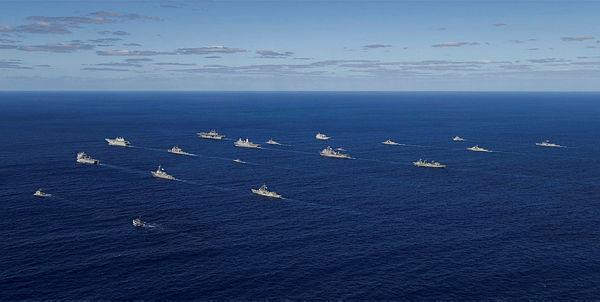
China has become the most formidable challenge to Asia’s regional order, and to Australia’s stake in that order, since the days of Japanese imperialism. It’s not just its growing economic and military power but increasingly Beijing is experimenting with order building and it’s plainly trying to exert political influence beyond its borders.
The heated and polarised debate in Australia about the consequences of China’s ‘sharp power’ is a notable consequence of this. And it has brought into focus the crucial issue of the future of the ‘rules-based order’ in the region, an image invoked by the Turnbull government in numerous speeches and policy statements.
Famously, the 2016 Defence White Paper used the term 56 times, defined a ‘stable global rules-based order’ as one of Australia’s three ‘core strategic interests’ and plainly stated that the country’s armed forces should be prepared to fight alongside allies and partners to defend this order. In comments following a recent speech at La Trobe University, Julie Bishop said that the country had to be prepared to fight to defend the order, the alternative being ‘catastrophic’.
But will Australia really defend the rules-based order in Asia? As we argue in the latest issue of Asian Survey, it’s too easy to dismiss the concept as an ‘increasingly meaningless expression’. Rather, the organisational weight of the ‘rules-based’ formulation shouldn’t be underestimated. Its emergence is a direct response to an international order in growing disarray and a reduced willingness and capacity of key countries to enforce those rules. After all, secondary powers such as Australia are price-takers in the international strategic balance.
Navigating great-power rivalry and the broader challenges of international politics are much more difficult when questions of raw power are determinative. A world in which ‘might makes right’ is considerably less appealing for Canberra than a world in which power is moderated by liberal ideas and rules, supported by a militarily powerful America. Simply put, Canberra has neither an interest in the emergence of a US–Sino ‘power-sharing arrangement’, nor in a China-centric regional order.
The government’s strong emphasis on the rules-based order is an effort to signal Australia’s willingness to join a broad ‘coalition against revisionism’ by major powers such as China. If the liberal international order in its current configuration ceases to exist, Australia is likely to opt for the ‘second best’ option. Led by America, this coalition would include democratic and non-democratic countries, and would be based on common interests (rather than common values) such as the prevention of Chinese hegemony in East Asia.
While more flexible and uncertain than the previous system—in that the US is likely to feel less restraint when its key interests are at stake—this coalition would still benefit Australia since the US would retain its rule-making authority because of its ongoing military and economic strength.
That’s why the Turnbull government has opted to remain close to our US ally, regardless of irritations about the Trump administration. Strategically, the 2016 Defence White Paper already paved the way for ever-closer cooperation and integration with the US military.
The decision to focus on a rules-based order and not on a liberal order in the white paper and in the 2017 Foreign Policy White Paper also opens the door to cooperation with non-democratic Asia–Pacific countries to defend the status quo. The Turnbull government deserves credit for assuming a key role in leading the strategic debate in the Indo-Pacific region about the challenges to the rules-based order and the need to defend it.
But there are risks in framing Australia’s strategic policy in this way. First, it’s not entirely clear if the United States under President Donald Trump is willing to underwrite this order to the same degree as past administrations. Without America’s commitment, Australia’s strong support for this order lacks its most important ingredient. Still, Washington’s ‘Free and Open Indo-Pacific’ concept is reassuring, as is Trump’s apparent willingness to push back against China on unfair trade and investment practices and his possible re-engagement with the TPP.
Second, there’s a risk that Canberra will fail to underwrite its ambitious declaratory support for the rules-based order with concrete action. The default position in the Australian debate remains that Australia shouldn’t support a stronger response against China (or initiate such a move on its own) in defence of this order if it risks escalation with Beijing.
In a contested Asia this position isn’t really tenable, yet the question remains: is Australia prepared to pursue policies alongside its US ally and others that reflect a new mix of competition and cooperation, with the balance tilting towards the former?
The jury is still out on the extent to which Australia will actually defend the rules-based order in Asia. On the one hand, more than most countries in the region, Australia has made clear its interest in protecting an order in which the interests of lesser powers are respected by the great powers, particularly China.
The strong emphasis at the level of defence planning documents also underscores Canberra’s preparedness to incur significant strategic costs, to work even more closely with its US ally, but also to expand and support strategic partners in the region. But the litmus test is yet to come.
Should China continue to push the boundaries of the acceptable, a failure to match declaratory policy and actions could prevent Canberra from effectively defending this order and could also reduce Australia’s value as an alliance partner to the United States. Australia thus cannot afford to be a bystander amidst Asia’s shifting order.

